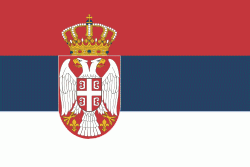Toba (Toba)
Toba (Тоба, Hungarian: Tóba) is a village in Serbia. It is situated in the Nova Crnja municipality, in the Central Banat District, Vojvodina province. The village has a Hungarian ethnic majority (84.08%) and its population numbering 691 people (2002 census).
The Field Marshal, Count Robert Zichy-Ferraris from the prominent Hungarian family of Zichy, established the settlement of the Toba in 1789. During the first half or 19th century, Zichy sold his property to Henry, Count of Chambord, pretender to the throne of France. Henry appointed Barron Cyril Billet as his governor. Baron Billet and his sons were managing property for approximately 50 years. During that period, they were playing important role in the social life of the region. The castle, small family residential house and Roman Catholic Church of Holy Trinity were built during that period. By the mid-19th century, settlement was known as the Great Toba, and the population of the village mostly consisted of the tobacco growers. After the death of Henry, Robert I, Duke of Parma inherited his property. After Duke's death, his son Elias of Bourbon-Parma sold the property to the Bank of Timișoara. After the World War I, whole region, which was once part of the Austro-Hungarian Monarchy, become the part of newly formed Kingdom of Yugoslavia.
After the World War II, modern Primary School with kindergarten, Cultural Center, Fire station and ambulance were built in the village.
The Field Marshal, Count Robert Zichy-Ferraris from the prominent Hungarian family of Zichy, established the settlement of the Toba in 1789. During the first half or 19th century, Zichy sold his property to Henry, Count of Chambord, pretender to the throne of France. Henry appointed Barron Cyril Billet as his governor. Baron Billet and his sons were managing property for approximately 50 years. During that period, they were playing important role in the social life of the region. The castle, small family residential house and Roman Catholic Church of Holy Trinity were built during that period. By the mid-19th century, settlement was known as the Great Toba, and the population of the village mostly consisted of the tobacco growers. After the death of Henry, Robert I, Duke of Parma inherited his property. After Duke's death, his son Elias of Bourbon-Parma sold the property to the Bank of Timișoara. After the World War I, whole region, which was once part of the Austro-Hungarian Monarchy, become the part of newly formed Kingdom of Yugoslavia.
After the World War II, modern Primary School with kindergarten, Cultural Center, Fire station and ambulance were built in the village.
Map - Toba (Toba)
Map
Country - Serbia
 |
 |
| Flag of Serbia | |
Continuously inhabited since the Paleolithic Age, the territory of modern-day Serbia faced Slavic migrations in the 6th century, establishing several regional states in the early Middle Ages at times recognised as tributaries to the Byzantine, Frankish and Hungarian kingdoms. The Serbian Kingdom obtained recognition by the Holy See and Constantinople in 1217, reaching its territorial apex in 1346 as the Serbian Empire. By the mid-16th century, the Ottomans annexed the entirety of modern-day Serbia; their rule was at times interrupted by the Habsburg Empire, which began expanding towards Central Serbia from the end of the 17th century while maintaining a foothold in Vojvodina. In the early 19th century, the Serbian Revolution established the nation-state as the region's first constitutional monarchy, which subsequently expanded its territory. Following casualties in World War I, and the subsequent unification of the former Habsburg crownland of Vojvodina with Serbia, the country co-founded Yugoslavia with other South Slavic nations, which would exist in various political formations until the Yugoslav Wars of the 1990s. During the breakup of Yugoslavia, Serbia formed a union with Montenegro, which was peacefully dissolved in 2006, restoring Serbia's independence as a sovereign state for the first time since 1918. In 2008, representatives of the Assembly of Kosovo unilaterally declared independence, with mixed responses from the international community while Serbia continues to claim it as part of its own sovereign territory.
Currency / Language
| ISO | Currency | Symbol | Significant figures |
|---|---|---|---|
| RSD | Serbian dinar | дин or din. | 2 |
| ISO | Language |
|---|---|
| BS | Bosnian language |
| HU | Hungarian language |
| SR | Serbian language |















